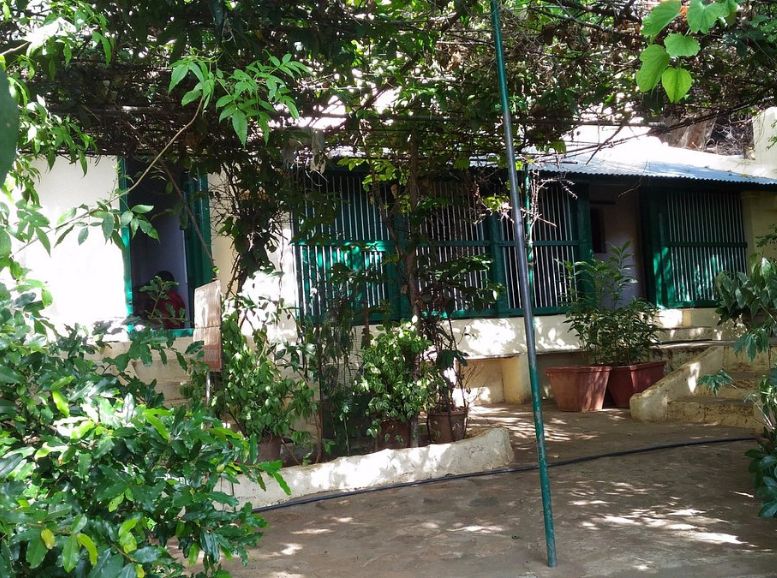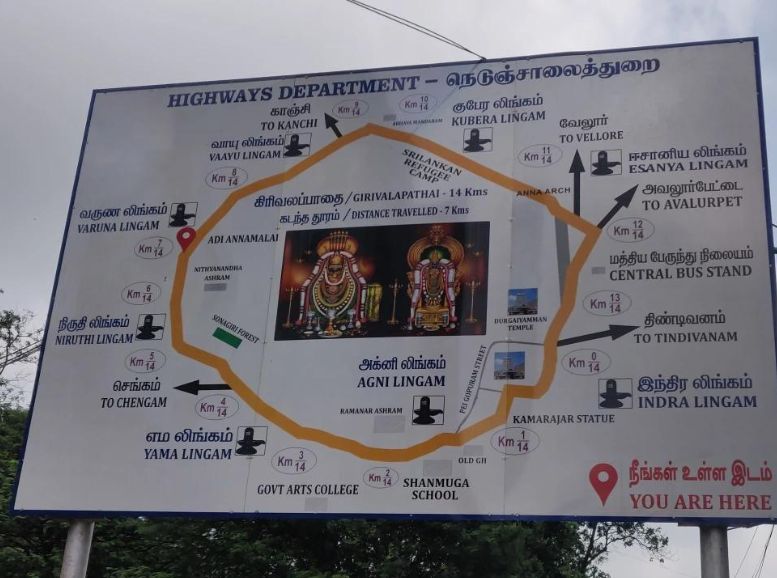Shrouded in the shadow of the Annamalai Hills in Tamil Nadu, Tiruvannamalai pulsates with spirituality and whispers of a bygone era. Renowned for its timeworn temples, peaceful ashrams, and the awe-inspiring Arunachala peak, Tiruvannamalai beckons the spiritual seeker and the adventurous traveler in equal measure.
Embark with us on a virtual voyage to Tiruvannamalai, where we’ll immerse ourselves in its vibrant cultural tapestry, profound spiritual significance, and the tranquility that embodies this sacred town. Let’s journey into the soul of Tiruvannamalai, where we’ll unveil its enigmatic allure and unearth the narratives that have been intricately woven into its ancient landscape for centuries. Welcome to Tiruvannamalai, a place where history, spirituality, and serenity converge to create an indelible experience.
How to reach:
Air:
Tiruvannamalai’s aerial gateway is Chennai International Airport, roughly 190 kilometers away. Taxis and buses are readily available at the airport for your onward journey to Tiruvannamalai.
Train:
The town boasts its own railway station, conveniently linked to major cities like Chennai, Bangalore, and Coimbatore. Upon arrival, taxis and auto-rickshaws are easily found to whisk you to your destination within Tiruvannamalai.
Road:
Tiruvannamalai enjoys excellent road connectivity to major cities in Tamil Nadu and neighboring states. Self-driving or taking a bus are both viable options. Regular bus services operate from Chennai, Bangalore, and other nearby areas.
Exploring Tiruvannamalai:
Once in town, navigating becomes a breeze with local buses, auto-rickshaws, and taxis at your disposal. For those seeking an independent exploration style, motorbike and bicycle rentals are available.
Best time to visit:
Pleasant Winters (October – March): Enjoy comfortable temperatures (20°C to 30°C) perfect for sightseeing, temple visits, and outdoor adventures. Witness the vibrant Karthigai Deepam festival (usually November/December) that draws devotees nationwide.
Warm Summers (April – June): Embrace warmer weather (25°C to 40°C) ideal for spiritual retreats and early morning hikes. Hike around Arunachala hill during the cooler mornings and evenings.
Monsoon Rains (July – September): Experience moderate to heavy rainfall (20°C to 30°C) that transforms the landscape. This season is ideal for nature lovers and photographers seeking a lush, vibrant Tiruvannamalai.
Attractions:
Arunachalesvara Temple:

Dominating the heart of Tiruvannamalai is the Arunachalesvara Temple, a majestic monument dedicated to Lord Shiva. Towering gopurams, or gateway towers, mark the entrance to this sprawling complex, one of India’s largest and most architecturally impressive temples. Its rich history stretches back over a thousand years, with each era adding its own layer of grandeur thanks to the contributions of various rulers. Visitors are invariably struck by the temple’s sheer scale, particularly the towering Rajagopuram that rises 217 feet into the sky. Within the complex, numerous mandapams (halls), tanks, and shrines weave a tapestry of spiritual significance, each detail whispering stories of the past. Every year, the temple comes alive during the spectacular Karthigai Deepam festival, a sight that draws devotees from across the country.
Arunachala Hill:

Towering over Tiruvannamalai isn’t just a hill; it’s Arunachala, the revered embodiment of Lord Shiva. Far more than a geographical feature, Arunachala is a spiritual powerhouse for millions. A sacred pilgrimage for devotees, especially on full moon days, is the Girivalam – a 14-kilometer circumambulation around the hill’s base. This path winds through dense forests, tranquil valleys, and past numerous shrines, each step imbued with spiritual significance. The summit of Arunachala rewards trekkers with breathtaking panoramic views, making it a favored spot for meditation and self-reflection.
Skandashramam:

Cradled on the slopes of Arunachala Hill, Skandashramam whispers tales of spiritual awakening. This serene cave and ashram hold deep significance, for it was here that Ramana Maharshi, a revered sage, spent years in profound meditation and self-discovery, ultimately reaching enlightenment. The ashram, imbued with the simplicity and tranquility Ramana Maharshi cherished, offers a haven for introspection and spiritual growth. Adorned with his teachings and pictures, the cave itself provides a peaceful refuge, a sanctuary from the everyday clamor.
Virupaksha Cave:

Steeped in spiritual significance, Virupaksha Cave whispers of Ramana Maharshi’s profound silence and meditation. Here, nestled halfway up Arunachala Hill, he resided for over 17 years. The cave itself exudes serenity, a contemplative haven for visitors seeking peace. Adorned with images and teachings of the sage, it invites you to experience the same quietude that nourished Ramana Maharshi’s spirit. Sit within the cave, meditate, and allow the lingering spiritual vibrations to wash over you.
Sathanur Dam:

Unwind amidst nature’s embrace at Sathanur Dam, a scenic escape roughly 30 kilometers from Tiruvannamalai. Lush greenery paints the landscape around this dam, offering breathtaking vistas of the rolling hills. Take to the calm waters on a boat ride, and soak in the tranquility. Ideal for a family outing or a friends’ gathering, Sathanur Dam’s serene atmosphere promises a delightful escape. Keep your eyes peeled for the vibrant birdlife that calls this place home – birdwatchers, rejoice!
Gingee Fort Tiruvannamalai:

Thirty kilometers from Tiruvannamalai, history buffs rejoice! Gingee Fort, also known as Senji Fort, crowns three majestic hills. This remarkable example of military architecture offers panoramic vistas of the countryside, whispering tales of a bygone era. The fort’s legacy stretches back to the 9th century, when it was controlled by the Chola dynasty. Over the centuries, it has borne witness to the rise and fall of empires, from the Vijayanagara to the Marathas and Mughals. Today, Gingee Fort stands as a powerful testament to the region’s vibrant past, a must-visit for history lovers and explorers alike.
Ramana Ashram:

Following the path of Sri Ramana Maharshi, one of modern India’s most revered sages, leads you to his ashram. Nestled at the foot of Arunachala Hill, it’s a haven of peace and spiritual exploration. Here, visitors can meditate in the very hall where Ramana Maharshi himself spent countless hours seeking enlightenment. Delve deeper into his wisdom by exploring the library and museum brimming with his life’s teachings. The ashram caters to the seeker’s journey with programs like meditation sessions, discourses, and yoga classes, all designed to foster self-discovery and inner transformation.
Girivalam Path:

Unfurl a sacred journey on the Girivalam Path, a 14-kilometer pilgrimage path that encircles the revered Arunachala Hill. Devotees embark on this circumambulation, seeking spiritual merit and blessings. The path unfolds like a sacred tapestry, dotted with temples, shrines, and meditation caves, each whispering tales of faith. Immerse yourself in the serene embrace of nature, and feel the vibrant spiritual energy of the hill course through you. The Girivalam is a transformative experience, leaving a lasting impact on both pilgrims and explorers.
Local Experiences:
1. Immerse Yourself in the Arunachalesvara Temple: Witness the vibrant energy of Tiruvannamalai by attending a puja (ritual) at the Arunachalesvara Temple. Witness the rhythmic chants and observe the elaborate ceremonies performed by the priests. During festivals like Karthigai Deepam, the temple truly comes alive, offering a glimpse into the region’s rich cultural and religious heritage.
2. Witness the Magic of Karthigai Deepam: If your pilgrimage to Tiruvannamalai falls between November and December, don’t miss the awe-inspiring Karthigai Deepam festival. The highlight is the illumination of a massive lamp atop Arunachala Hill, visible for miles around. Witnessing this glowing beacon against the night sky is a truly mesmerizing experience.
3. Find Inner Peace at Skandashramam: Seek tranquility and inner peace through meditation at Skandashramam, a serene cave and ashram linked to Sri Ramana Maharshi. Nestled on the slopes of Arunachala Hill, the ashram provides a peaceful refuge from daily life’s hustle and bustle. Spend time in quiet contemplation, absorbing the spiritual energy that permeates the surroundings.
4. Embark on a Spiritual Walk: The Girivalam Path: Undertake a spiritual odyssey with the Girivalam, a 14-kilometer circumambulation around Arunachala Hill. The path winds through dense forests, tranquil valleys, and numerous shrines, offering breathtaking vistas of the landscape. Experience the profound peace and sense of oneness that comes from following in the footsteps of countless pilgrims and seekers.
5. Unveiling the Past at Gingee Fort: Delve into the region’s rich history by exploring Gingee Fort, also known as Senji Fort. Spread majestically across three hills, the fort complex is a remarkable testament to military architecture and boasts panoramic vistas of the surrounding countryside. Explore the fort’s various structures, including granaries, temples, and defensive walls, and uncover its fascinating past.
6. Pay Homage at Virupaksha Cave: Honor one of modern India’s greatest sages by visiting the Virupaksha Cave, where Sri Ramana Maharshi spent over 17 years in profound silence and meditation. Nestled halfway up Arunachala Hill, the cave offers a serene and contemplative atmosphere for visitors. Meditate within the cave and attempt to experience the same tranquility and peace that the sage himself achieved here.
7. Picnic by the Sathanur Dam: Embrace nature with a delightful picnic at Sathanur Dam, located roughly 30 kilometers from Tiruvannamalai. Lush greenery surrounds the dam, offering breathtaking vistas of the rolling hills. Take a boat ride on the calm waters and soak in the natural beauty. Relax by the tranquil dam and rejuvenate in the fresh air.
8. Discover Local Treasures: Explore the vibrant markets of Tiruvannamalai and browse the exquisite handicrafts and souvenirs. From traditional handloom textiles to intricate wooden carvings, the markets showcase the region’s rich cultural heritage. Don’t forget to pick up some delectable Tiruvannamalai specialties, like the famed Panchamirtham, a sweet treat made with five fruits.
Travel tips:
Embrace the Perfect Weather (October to March): Tiruvannamalai shines during the winter months. Pleasant temperatures make sightseeing and outdoor activities effortless.
Respect the Sacred Space: Remember, Tiruvannamalai is steeped in religious traditions. Dress modestly when visiting temples and ashrams, and be mindful of local customs.
Full Moon Magic (Plan Accordingly): If possible, align your visit with a full moon. The Girivalam, a sacred 14-kilometer circumambulation around Arunachala Hill, is believed to hold immense spiritual significance on these days.
Fuel Up for Your Adventures: Whether you’re tackling the Girivalam or exploring temples, pack plenty of water and snacks. The journey can be long, and staying hydrated is key.
Plan Your Stay (Especially During Peak Season): Tiruvannamalai is a popular pilgrimage destination. To avoid last-minute scrambles, book your accommodation well in advance, particularly during peak season.
A Culinary Journey Awaits: Don’t miss the chance to tantalize your taste buds with Tiruvannamalai’s delectable cuisine. From classic South Indian fare to local specialties like Panchamirtham and Milagu Vadai, there’s a world of flavors to discover.
Travel with Care: Be a responsible tourist! Help preserve the natural beauty and cultural heritage of Tiruvannamalai. Minimize waste, respect the environment, and support local businesses and artisans.
A Few Tamil Phrases go a Long Way: While English is spoken by some locals, learning a few basic Tamil phrases can enhance your interactions and create a more meaningful experience.
Be Weather-Ready: The winter months may be pleasant, but Tiruvannamalai’s weather can be unpredictable. Pack for potential changes, especially if you plan outdoor activities.
Courtesy is Key (Photography): Always seek permission before taking photographs, particularly in temples, ashrams, and other religious sites. Be respectful of people and ongoing rituals.
Conclusion
Tiruvannamalai, a tapestry woven with rich culture, profound spirituality, and captivating natural beauty, beckons travelers from all walks of life. Towering temples like Arunachalesvara stand alongside serene retreats like Skandashramam, while breathtaking vistas unfold from atop Arunachala Hill. Pilgrims seeking enlightenment and explorers yearning for Tamil Nadu’s heritage will find themselves equally captivated. Infectious energy mingles with peaceful surroundings, creating a sanctuary for rejuvenation. Explore ancient temples, meditate in serene caves, and embark on the spiritual journey of the Girivalam circumambulation. As you delve deeper, a profound sense of peace and tranquility will embrace you, leaving a lasting impression long after your departure. Ready to embark on this transformative journey? Discover Tiruvannamalai’s magic for yourself and plan your unforgettable adventure with Xplro.com.
FAQs
1. What is Tiruvannamalai famous for?
- Tiruvannamalai is famous for its ancient temples, especially the Arunachalesvara Temple dedicated to Lord Shiva. It is also renowned as a spiritual destination, attracting thousands of devotees and seekers from all over the world.
2. What is Girivalam in Tiruvannamalai?
- Girivalam is the practice of circumambulating the Arunachala Hill on foot. It is considered a sacred ritual and is believed to confer great spiritual merit. The path around the hill is approximately 14 kilometers long and is undertaken by thousands of devotees, especially during full moon days.
3. When is the best time to visit Tiruvannamalai?
- The best time to visit Tiruvannamalai is during the winter months, from October to March, when the weather is pleasant and ideal for sightseeing and outdoor activities.
4. What are the must-visit attractions in Tiruvannamalai?
- Some of the must-visit attractions in Tiruvannamalai include the Arunachalesvara Temple, Arunachala Hill, Skandashramam, Virupaksha Cave, Sathanur Dam, Gingee Fort, and Ramana Ashram.
5. How do I reach Tiruvannamalai?
- Tiruvannamalai can be reached by air, train, or road. The nearest airport is Chennai International Airport, the nearest railway station is Tiruvannamalai Railway Station, and the town is well-connected by road to major cities in Tamil Nadu and neighboring states.
6. What is the significance of Karthigai Deepam festival in Tiruvannamalai?
- Karthigai Deepam is a grand festival celebrated in Tiruvannamalai during November or December. The highlight of the festival is the lighting of a huge lamp atop the Arunachala Hill, which is visible from miles around. It is a spectacular sight and attracts thousands of devotees.
7. Can I undertake Girivalam at any time?
- Yes, Girivalam can be undertaken at any time. However, it is considered especially auspicious to do so during full moon days.
8. Are there any accommodations available in Tiruvannamalai?
- Yes, Tiruvannamalai offers a range of accommodations to suit every budget, including hotels, guesthouses, lodges, and ashrams. It is advisable to book your accommodation in advance, especially during the peak season.
9. What are some local delicacies to try in Tiruvannamalai?
- Some local delicacies to try in Tiruvannamalai include Panchamirtham, Milagu Vadai, traditional South Indian dishes, and local sweets.





